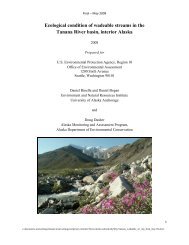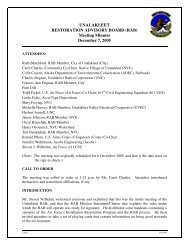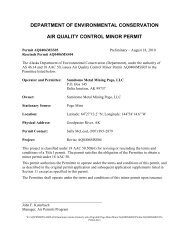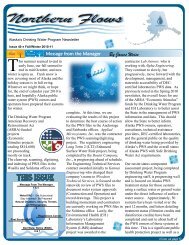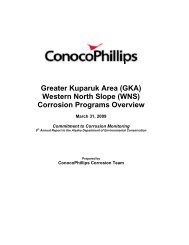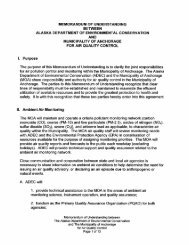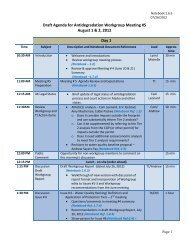2012 Ocean Ranger Guidebook Revision 3-7-12 - Alaska ...
2012 Ocean Ranger Guidebook Revision 3-7-12 - Alaska ...
2012 Ocean Ranger Guidebook Revision 3-7-12 - Alaska ...
You also want an ePaper? Increase the reach of your titles
YUMPU automatically turns print PDFs into web optimized ePapers that Google loves.
<strong>20<strong>12</strong></strong> <strong>Ocean</strong> <strong>Ranger</strong> <strong>Guidebook</strong> 3-7-<strong>12</strong><br />
Figure 4- Waste stored<br />
Citation: 40 CFR 265.17 General requirements for ignitable, reactive, or incompatible wastes.<br />
(a) The owner or operator must take precautions to prevent accidental ignition or reaction of ignitable or reactive<br />
waste. This waste must be separated and protected from sources of ignition or reaction including but not limited<br />
to: Open flames, smoking, cutting and welding, hot surfaces, frictional heat, sparks (static, electrical, or<br />
mechanical), spontaneous ignition (e.g., from heat-producing chemical reactions), and radiant heat. While ignitable<br />
or reactive waste is being handled, the owner or operator must confine smoking and open flame to specially<br />
designated locations. ‘‘No Smoking’’ signs must be conspicuously placed wherever there is a hazard from ignitable<br />
or reactive waste.<br />
(b) Where specifically required by other sections of this part, the treatment, storage, or disposal of ignitable or<br />
reactive waste, and the mixture or commingling of incompatible wastes, or incompatible wastes and materials,<br />
must be conducted so that it does not:<br />
(1) Generate extreme heat or pressure, fire or explosion, or violent reaction;<br />
(2) Produce uncontrolled toxic mists, fumes, dusts, or gases in sufficient quantities to threaten human health;<br />
(3) Produce uncontrolled flammable fumes or gases in sufficient quantities to pose a risk of fire or explosions;<br />
Job Aid Item: 3.2.c<br />
Text: The controlled storage processing or disposal facilities or treatment used is IAW (18 AAC 69.040)<br />
Crew training in off loading procedures is IAW (18 AAC 69.040).<br />
Background: Cruise ships are required (if offloading hazardous waste in <strong>Alaska</strong>) to document planned<br />
methods, training, and facilities used in their hazardous waste offload plans. Most ships do not offload<br />
hazardous waste in <strong>Alaska</strong>.<br />
What to check for: If the ship offloads hazardous waste in <strong>Alaska</strong>, check that offloads and crew<br />
training match those in the current hazardous waste offload plan. Check also the packaging of the<br />
offloaded materials.<br />
Citations: See General Citations for this section.<br />
Job Aid Item: 3.2.d<br />
Text: There is a designated person-in charge, each entry signed by Officer-in-Charge and each page by<br />
Master. 33 CFR 151.55 (d)<br />
<strong>12</strong>2






